Pretty Plant Combinations to Suit Any Garden Style
It’s easy to pick out pretty plants at the garden center, but how do you know which plants will go well together in the garden or in your patio pots? We’re sharing 20 beautiful ideas with you here, complete with details like how much sun and water they’ll need to thrive.
Let’s get started!
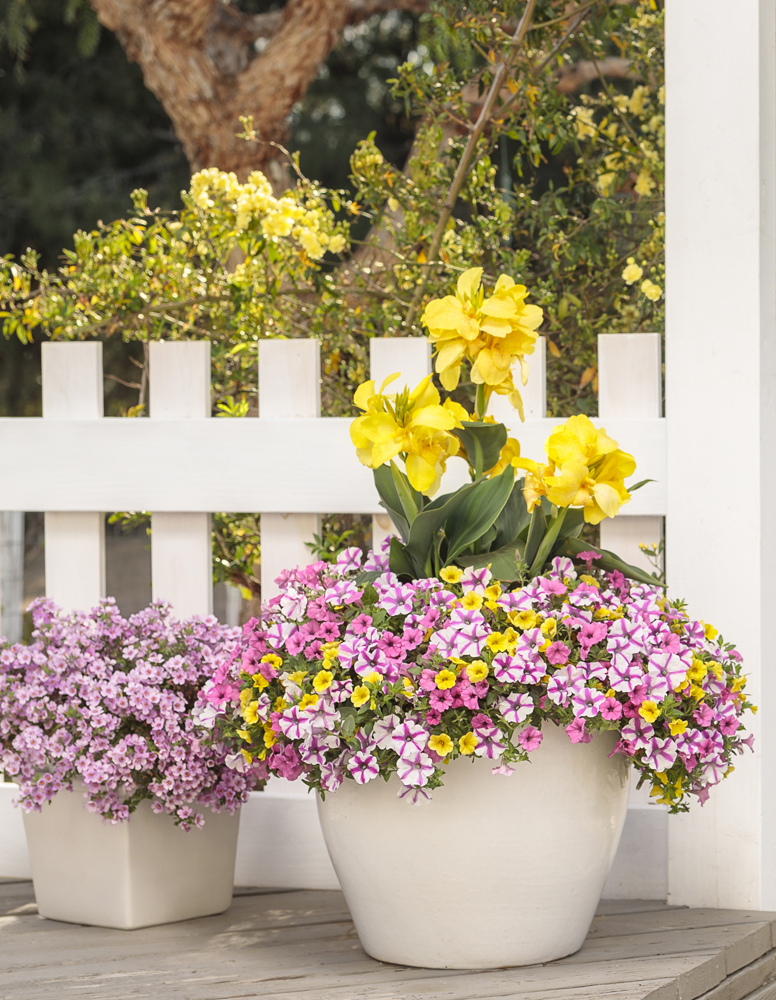
Supertunias + Superbells
Combining two of our best-selling flower types – Supertunia® petunias and Superbells® calibrachoa – creates a dynamic flower show that lasts all the way from spring into fall. They’ll grow best together in containers that drain freely rather than in the ground and will thrive in full sun to part sun.
Here are a few tips for keeping petunias and calibrachoa growing happily together.
- Supertunias are more vigorous than Superbells, so if you want the Superbells to shine in a container recipe, use fewer petunias and more calibrachoa.
- Superbells generally need less water than Supertunias. The petunias will happily soak up any moisture the calibrachoa don’t want. Don’t keep the soil wet all the time—let it dry down a bit between waterings.
- Superbells are more finicky when it comes to soil pH. That’s one reason why it is easier to grow them in containers with fresh potting soil. If their foliage starts to turn lighter green, it may be because the soil pH is too high for them to be able to absorb iron. To correct the issue, feed them with Proven Winners’ water soluble plant food. Our brand of fertilizer contains a special form of iron called EDDHA which is more easily absorbed by plants when the soil pH is high. Most other brands of fertilizer use a less expensive, but less effective form of iron that won’t benefit plants like calibrachoa grown in more alkaline conditions.
Find more tips on growing and maintaining Supertunia petunias here and Superbells calibrachoa here.

Powerhouse Combination
You’ve heard us talk about matching up plants with similar vigor, and here is a perfect example. Supertunia Vista® Bubblegum® petunias are an excellent planting partner for Graceful Grasses® Vertigo® purple fountain grass because they are both extra-vigorous, thrive in full sun and enjoy average moisture.
Since Supertunia Vista petunias can grow up to 2’ tall, they are in scale with this 4-8’ tall fountain grass. If we had used a shorter grass here, like a 3’ tall purple fountain grass, it may have become buried in a sea of petunias. By matching annual plants of similar vigor, it ensures they will grow in harmony with one another and reach their full potential.
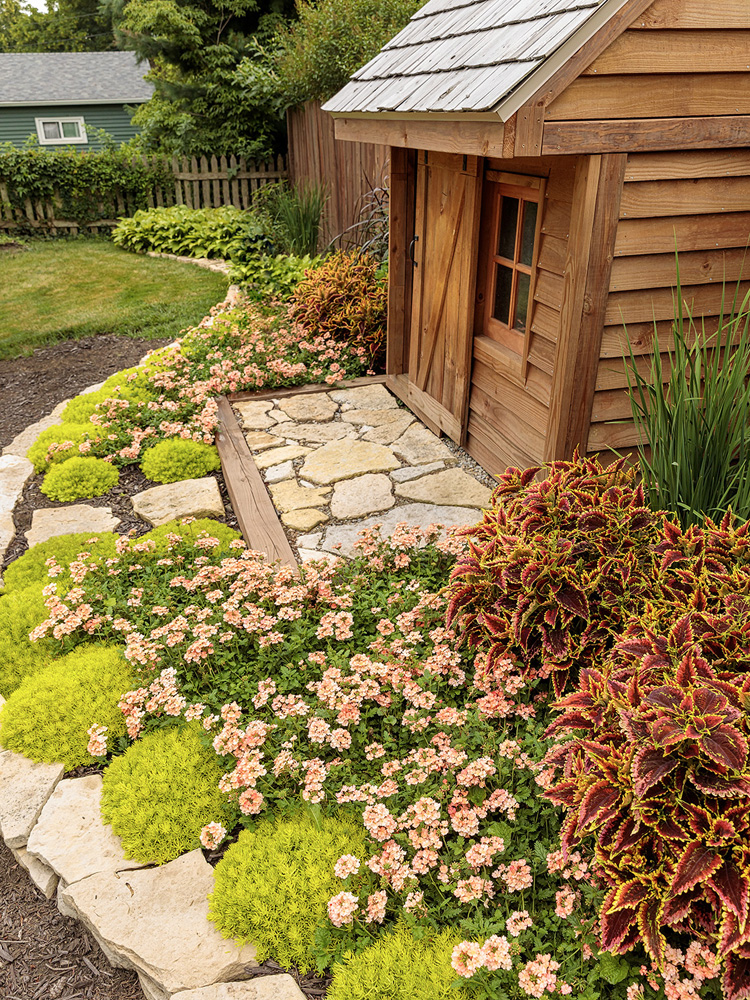
Pretty in Peach
The warm peach, red and yellow tones of this landscape pairing create a welcoming atmosphere and really shine when the heat of summer settles in. It combines two annuals—ColorBlaze® El Brighto coleus and Superbena® Peachy Keen verbena—with an edging of zone 7 hardy Lemon Coral® sedum. (‘Angelina’s Teacup’ sedum could be substituted as a perennial version for zones 4-9.)
Why this pairing works:
- The plants all prefer full sun to part sun and average moisture.
- Well-drained soil with a bit of Proven Winners’ continuous release plant food mixed in will make all of these plants happy. Supplement with water soluble plant food once or twice per month.
- All of the plant colors are complementary. The many colors of the patterned coleus are echoed individually in the verbena and sedum.
- The textures are nicely balanced, moving from finely textured sedum in front to the more coarsely textured coleus in the back.
- The layered planting style, with the plants arranged from shortest to tallest, shows each plant off beautifully.
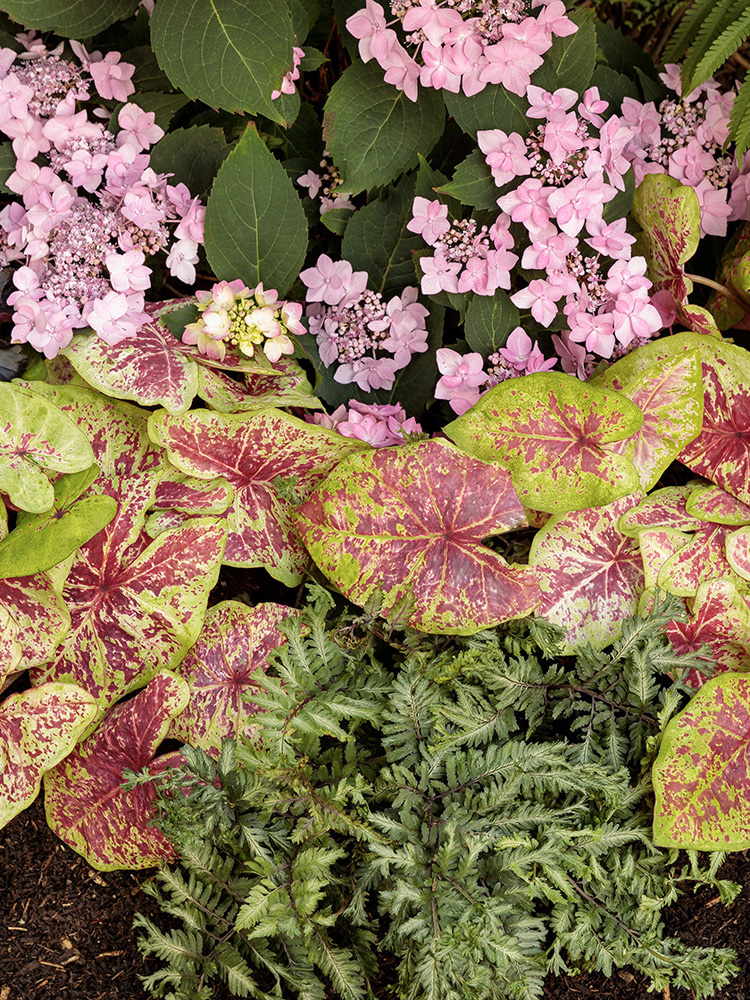
All-Season Interest in Shade
Hydrangeas are like potato chips. Once you grow one, you need to collect more. We’re often asked which kinds of plants pair well with them, so here is one colorful idea that takes advantage of the fun foliage of caladiums and ferns. Even when the hydrangea isn’t flowering, there is plenty of color and textural interest to enjoy.
Here, Let’s Dance Can Do!® reblooming hydrangeas are underplanted with Heart to Heart® ‘Raspberry Moon’ caladiums and ‘Crested Surf’ Japanese painted ferns in a part shade location that receives 4 to 6 hours of sun per day. They all thrive in rich, moist soil that is well-drained. If that doesn’t sound like the conditions you have to offer, consider pairing them together in a large container instead.
Find more fab foliage plants for shade in this article.

Midsummer Night’s Dream
This magnetic trio of chartreuse and purple plants will draw your eye beginning in midsummer when they all come into full bloom. The purple lollipop-shaped blossoms that top ‘Serendipity’ allium really pop against the bright chartreuse gold foliage of ‘Lemon Squeeze’ hardy fountain grass which also blooms the same time of year. In the background, you can see the glowing gold foliage of ‘Drops of Jupiter’ ornamental oregano which has rosy purple flowers of its own.
Both the allium and oregano are absolute magnets for pollinating bees and butterflies when in bloom. You’ll see them hard at work collecting pollen on every single sunny day. And since the foliage has an herbal scent, deer and rabbits tend to pass them right on by. It’s the best of both worlds!
Grow this trio in full sun, even in warm climates. Well-drained soil is important, but you won’t need to worry about amending it to be especially rich. These plants all will grow in good ‘ole garden soil. Hardiness: ‘Serendipity’ allium, zone 4-8; ‘Lemon Squeeze’ fountain grass, zone 5-9; ‘Drops of Jupiter’ oregano, zone 4-9.

Black and White Garden Design
Black and white flowers and plants paired together, either interspersed randomly or in an intentional pattern, brings instant sophistication to a garden design. The effect is especially striking when done on a larger scale.
Here, Primo® ‘Black Pearl’ coral bells are paired with Magic Show® ‘White Wands’ spike speedwell in a full sun garden in zone 5. The tiny white blossoms that dangle from the tall, black flower scapes of the coral bells echo the pointy white wands of neighboring plants in midsummer. If you find that coral bells need more shade in your warm climate, try subbing Sweet Caroline Raven™ sweet potato vine instead.
Explore more ways to use the color black in your garden designs in this article. Into goth gardening? You’ll like this.

Primary Color Matchup
Bold primary colors like red, yellow and blue are especially striking in full sun gardens because they remain fully saturated under those intense rays. That’s in contrast to pastel colors which tend to appear even lighter in full sun and can look washed out. If your garden is in a wide open space or in a spot where it receives intense afternoon sun, consider using primary colors in your design for greater visual impact.
In this pairing, the huge, scarlet red blossoms of Summerific® ‘Holy Grail’ perennial hibiscus visually bounce off the golden yellow flowers of ‘Tuscan Sun’ false sunflowers. These two primary colors are complementary, but each holds its own in the design. When the sunflowers are more mature, they will completely surround the hibiscus. Both thrive in full sun and moist soil in zones 4-9 and bloom from midsummer into early fall.
Find 10 more companions for Summerific hibiscus in this article.

Summertime Butterfly Buffet
Here’s a landscape combination you may not have tried yet—butterfly bush + hydrangeas. At first glance, you might wonder how this could work. Here’s the low down.
Pugster Periwinkle® butterfly bush is hardy in zones 5-9 and prefers full sun in all zones. Incrediball® smooth hydrangea (H. arborescens) is hardy in zones 3-8. It grows and blooms best in full sun in cooler zones but prefers some afternoon shade in warmer climates. If you overlap the two requirements, you can see how both shrubs would thrive together in full sun in zones 5-7.
Indeed, this scene was photographed in our trial gardens in zone 6. The butterfly bush face south, and a row of small serviceberry trees lightly shade the hydrangeas on the north side of the bed. Incrediball flowers earlier in the summer than butterfly bush, bearing huge, white mophead blossoms. They age to a lush jade green and make a beautiful backdrop for the periwinkle purple butterfly bush flowers that appear from midsummer through fall.
Butterfly bush are drought tolerant once established but also grow well with average moisture as long as the soil is well-drained. Smooth hydrangeas prefer average amounts of moisture too, which makes them a better fit in this pairing than bigleaf hydrangeas which would need more water. Any moisture the butterfly bush doesn’t soak up, the trees will be happy to use.

Low Maintenance, All-Season Shrub Border
Here’s a low maintenance, colorful pairing for full sun to part sun landscapes with average to moist soil. Meet Fluffy® western arborvitae and its planting partner, Invincibelle Garnetta® smooth hydrangea, photographed in our zone 6 trial garden in late summer.
Fluffy® is a golden, conical-shaped western arborvitae (Thuja plicata) that matures to 5-10’ tall x 3-6’ wide. It keeps its vivid coloring all season and has good winter color retention. It grows in zones 5-8 where it prefers full sun to part sun. If you would like something similar but more deer resistant than arborvitae, try swapping Fluffy out for Soft Serve® Gold false cypress (zone 4-8) or Pinpoint® Gold juniper (zone 5-7).
Invincibelle Garnetta® smooth hydrangea (H. arborescens) is a 2 ½’ tall shrub that grows in full sun to part shade in zones 3-8. It blooms reliably every year beginning a few weeks later than our other Invincibelle hydrangeas and reblooms for much of the summer. Rich garnet flower buds open to lush pink blossoms on strong stems that don’t flop. They make gorgeous cut flowers, both fresh and dried.
Want to see more ideas on how to incorporate evergreens into your landscape? Check out this article.
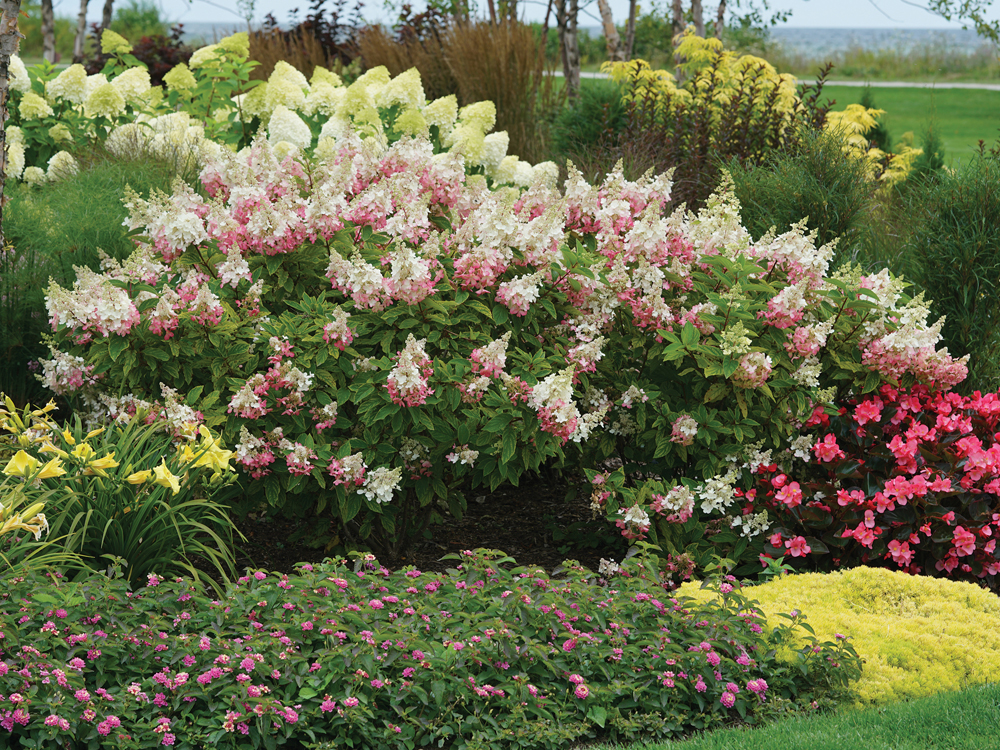
Stunning Mixed Border with Panicle Hydrangeas
This gorgeous mixed border has it all—stunning panicle hydrangeas, long blooming perennials, fantastic foliage plants, and annuals that bring color to the space from spring to fall. From front to back, left to right:
- Luscious® Royale Cosmo lantana – annual except in zones 9-11, full sun
- Lemon Coral® sedum – annual except in zones 7-11, part sun to full sun
- Surefire® Rose begonia – annual except in zones 10-11, sun or shade
- Rainbow Rhythm® ‘Going Bananas’ daylily – perennial in zones 3-9, part sun to full sun
- Pinky Winky® panicle hydrangea ( paniculata) – shrub for zones 3-8, part sun to full sun
- ‘Limelight’ panicle hydrangea ( paniculata) – shrub for zones 3-9, part sun to full sun
- Winecraft Black® smokebush – shrub for zones 4-8, full sun
- Lemony Lace® elderberry – shrub for zones 3-7, part sun to full sun
Did you know that not all panicle hydrangeas bloom at the same time? Some, like Little Quick Fire®, bloom very early in the summer compared to late varieties like ‘Limelight’. In the landscape pictured, the designer paired midsummer bloomer Pinky Winky with late blooming ‘Limelight’ panicle hydrangeas so there would be hydrangeas flowering from July to October. By the time ‘Limelight’ is coming into bloom, Pinky Winky’s flowers are already transitioning from white to pink. You will find a chart showing the relative bloom times on each panicle hydrangea plant record on our website.
This prismatic display of annuals, perennials and shrubs will grow beautifully in full sun to light shade with average moisture. By pairing plants that can all go a few days between watering, it makes it easy to satisfy all of their needs on the same sprinkler zone.

Heavenly Hydrangea Pairing
Gorgeous flowering hydrangeas are some of the most widely planted shrubs across North America. If you’re struggling to know what to pair with them, first take a look at how much space you have to work with. In most cases, you’ll want low growing plants like the Dolce® ‘Wildberry’ coral bells you see here to grow around the base of your hydrangeas. By using something short, you won’t cover up any of those amazing hydrangea blooms.
A few more details make this a perfect plant pairing:
- The soft pink tones of the Invincibelle Spirit II® smooth hydrangea flowers pictured here coordinate beautifully with the fruity purple tones of the coral bells.
- Both enjoy similar growing conditions.
- In the North, they will thrive together in full sun to part sun. In the South, they will both need some protection from the hot afternoon sun.
- Both enjoy average amounts of moisture, meaning the soil isn’t soggy but doesn’t dry out either.
- Both need well-drained soil.
- Their hardiness zones are similar. Invincibelle Spirit II smooth hydrangea: zones 3-8. Dolce® ‘Wildberry’: zones 4-9.
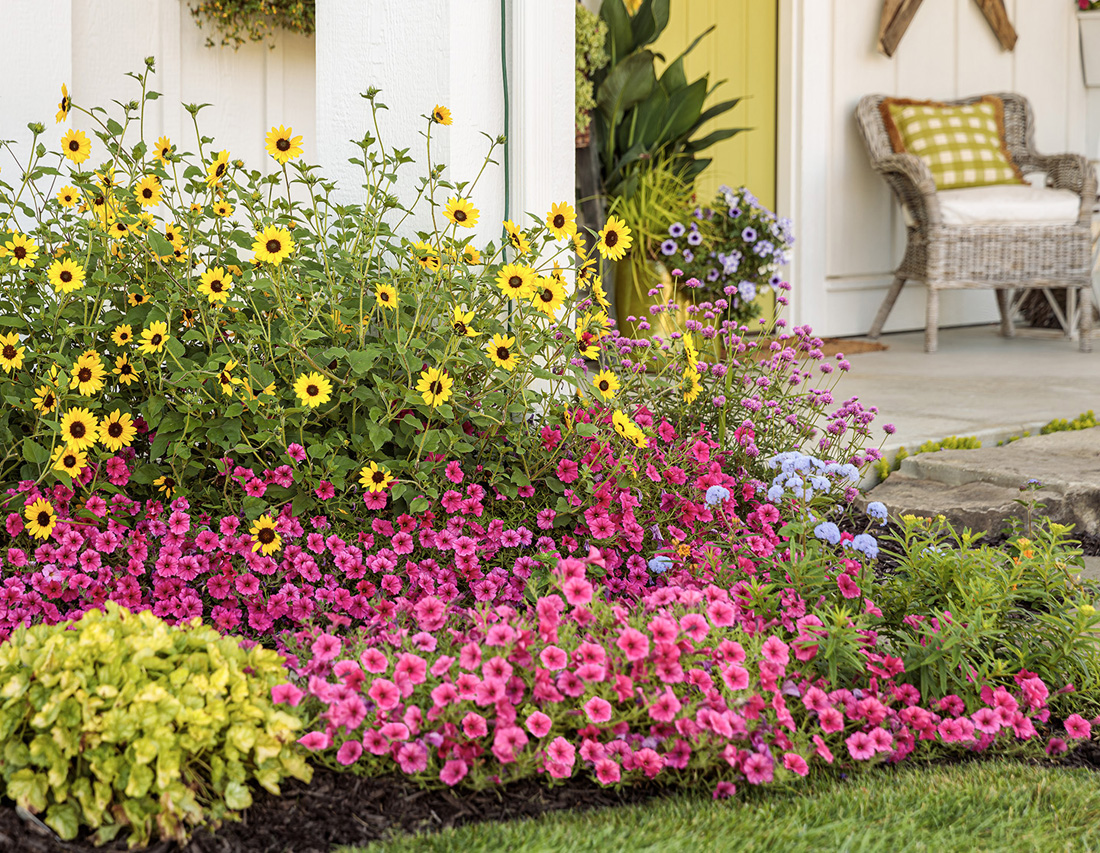
Bold Colors, Strong Plants
When you grow our extra-vigorous Supertunia Vista® petunias, you’ll need to pair them with something equally vigorous to make it a perfect pairing. If you choose a partner that is too small or grows slowly, it can quickly be swallowed up by all those petunia blooms. Don’t underestimate how large and fast they will grow.
Here, our Suncredible® Yellow multiflora sunflowers are paired perfectly with Supertunia Vista® Paradise petunias. Both are strong, quick growers that thrive in full sun and warm, summer weather. They need average amounts of moisture and appreciate an application of continuous release plant food mixed into the soil when you plant them. Since the sunflowers grow at least 2-3’ tall, they’ll grow big enough to be seen behind the petunias without being overrun.
Want more ideas for what to plant with Supertunia Vista® petunias? Here’s a list of recipes.

Elegant Texture for Shade
If you garden in the shade, you probably are already growing some hostas. While they have interesting foliage, you can spruce up that space even more by adding a few colorful caladiums and silver speckled lungwort foliage. Ferns make a great textural addition, too. Here, Heart to Heart® ‘Splash of Wine’ caladiums are paired with ‘Spot On’ lungwort and young Shadowland® ‘Wheee!’ and ‘Waterslide’ hostas. As the hostas mature and gain more of their mature traits, the blend of textures will be even more outstanding.
What makes this a perfect plant pairing:
- All of the plants prefer part shade to nearly full shade conditions and rich, moist soil.
- The shapes of the leaves are all similar, producing a quilt-like effect.
- The soft pastel tones comprise a soothing color palette.
- These plants all grow at about the same rate and have a similar habit, so they won’t overrun one another as they mature.
- Hostas and lungwort are both hardy in zones 3-9. The caladiums are replanted each year.
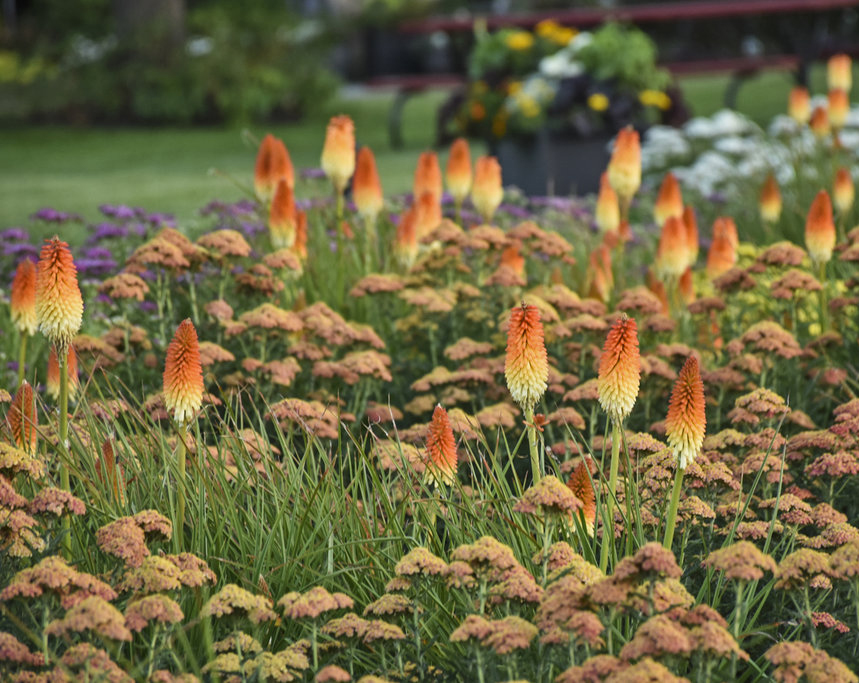
Hot Fun in the Summertime
This whimsical pairing of Pyromania® ‘Hot and Cold’ red hot pokers and ‘Firefly Peach Sky’ yarrow is at its peak in midsummer when both perennials are in full bloom. But the show doesn’t stop there! Since both varieties are rebloomers, you’ll get a repeat performance after a brief lull, lasting until the fall. By planting two varieties with similar orange tones, you’ll create a monochromatic effect in your design.
Both of these perennials need full sun, heat, average well-drained soil, and no supplemental fertilizer to grow well. Plant them where the sprinklers barely reach—daily watering would be their demise. Firefly yarrow is hardy in zones 3-8. Our red hot pokers grow in zones 5b-9.

Easy Foundation Bed Makeover
Here’s a unique solution to liven up boring foundation plantings for the summertime. If your traditional home has a row of evergreens growing up along the foundation with nothing in front of them, consider widening your bed to accommodate some colorful annuals. By doing so, you’ll retain the coverage in winter but bring far more curb appeal to the bed in the summer.
Here, a grouping of 2 to 2 ½’ tall annual ‘Sky Rocket’ grasses was planted in front of a row of evergreen shrubs that are up against the house. In front of them, a mass of 6-12” low growing Supertunia Mini Vista® petunias in shades of White and Violet Star was planted between the grasses and rock border. You can use any shade of petunias you like, just make sure to choose these shorter Mini Vistas so your grasses won’t get overrun. They will form a solid carpet of flowers that lasts from planting time until frost without deadheading.
Grow this combination in full sun with average moisture in all but the hottest climates in the summertime. An application of continuous release plant food mixed into the soil when you plant will help your flowers thrive all season.
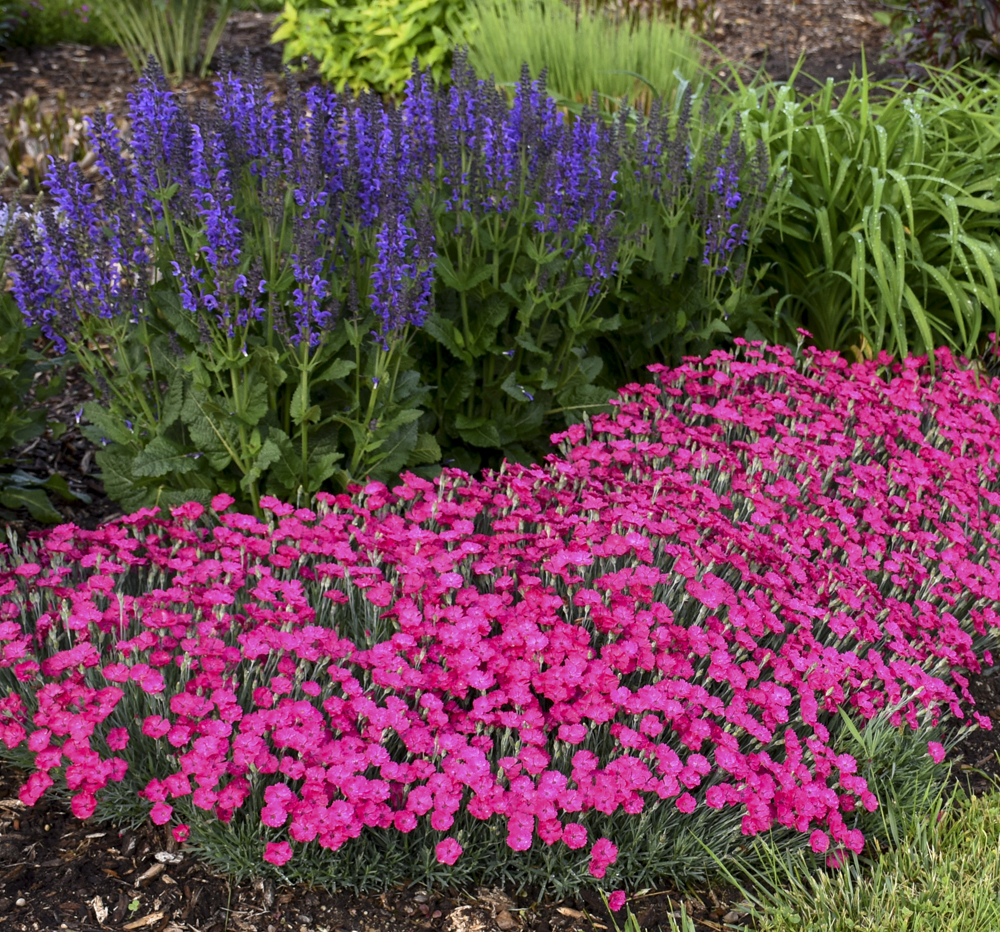
Early Summer Eye-Catcher
While it’s a good idea to plant perennials that bloom at different times so there’s always something flowering in your landscape, small pairings of plants that bloom together are always eye-catching. A classic combination for early summer (or late spring in the South) is dianthus and salvia. Here, a 6-8” tall grouping of ‘Paint the Town Magenta’ dianthus is planted in front of a 20-22” tall clump of Color Spires® ‘Indiglo Girl’ perennial salvia. Both share a similar bloom time early in the season, with some rebloom throughout the summer and early fall.
A few more details make this a perfect plant pairing:
- Both plants need 6+ hours of sun to flower prolifically. They do not grow well in shade.
- Both like the same kind of soil—well-drained soil that’s not too rich in nutrients and dries out a bit between waterings.
- The contrasting shape and scale of the plants creates a layering effect with the taller plants in back and a carpet of shorter plants in front.
- Their hardiness zones are similar. ‘Indiglo Girl’ salvia: zones 3-8. ‘Paint the Town Magenta’ dianthus: zones 4-9.
- Both plants are fragrant, which helps them be more deer resistant and attract pollinators.
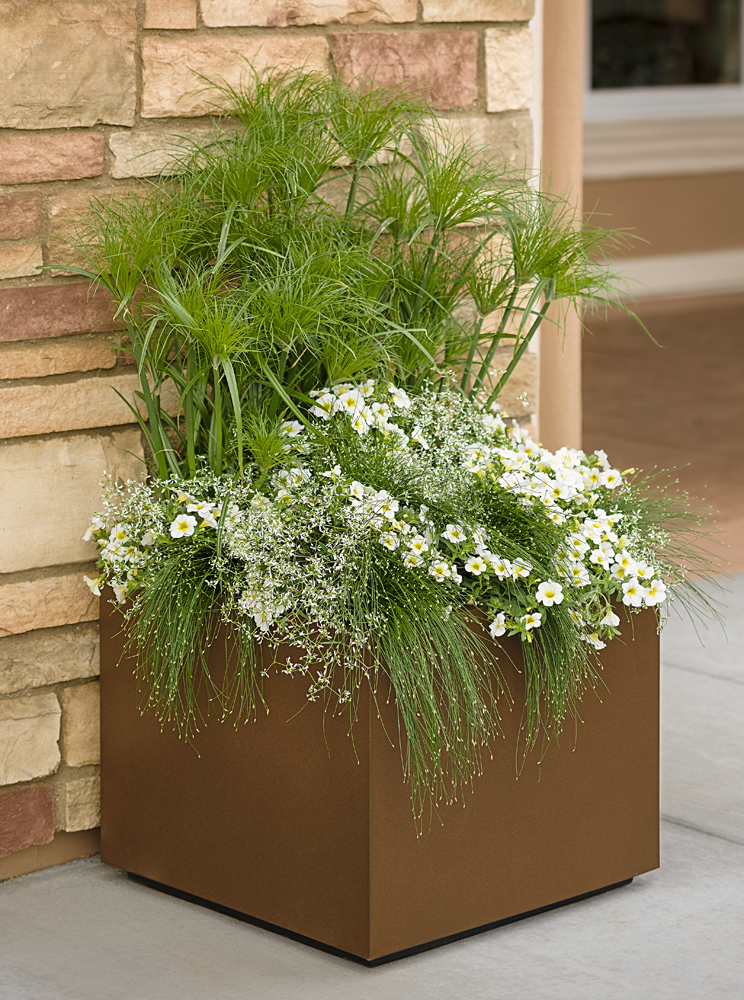
Elegant COR-TEN® Steel Container Planting
If an elegant, upscale container planting is just what your sunny space needs, try this perfect plant pairing in a large COR-TEN® steel planter. The recipe, named Rustic Chic, combines these elements:
- Prince Tut® Cyperus grass - thriller
- Fiber Optic grass - spiller
- Diamond Frost® euphorbia - filler
- Superbells® Over Easy™ calibrachoa – filler and spiller
A monochromatic white palette paired with verdant greens brings a clean, bright feeling and simply elegant look to this container. While both grasses prefer consistent moisture, the calibrachoa and euphorbia won’t mind that their planting partners steal some of the moisture away between waterings. Both types of flowers need only average moisture to thrive. A weekly to bi-weekly application of water-soluble plant food focused around the calibrachoa is recommended.
Learn more about how to pair plants together successfully in containers in this article.

A Flowering Succulent Carpet
Along the edge of a dry, sunny flower bed or pathway, or planted at the feet of a heat-tolerant shrub is where this carpet of succulents will thrive. It combines the fantastic textural foliage of Lemon Coral® sedum with the all-summer flowering Mojave® Fuchsia moss rose to create a vibrant mass of cheerful color all season. Since they share a similar growth rate, you won’t have to worry about one outcompeting the other for space.
Going away for the weekend or forgetting to water for a few days won’t set these drought tolerant succulents back. They continue to shine through the heat and won’t need to be fertilized to stay in bloom from planting time until frost. Though Lemon Coral sedum is perennial in zones 7-11, you’ll want to replant annual Mojave moss roses each spring. Try a different color every year! They come in these five fun colors.

Purple + Chartreuse = A Winning Combination Every Time
If you struggle with color pairings, try purple and chartreuse together. It works every time, whether you’re looking for container companions or larger plantings for the landscape. Here, we’ve paired ‘Miss Violet’ butterfly bush with Fluffy® Western arborvitae. The purple-violet summertime blooms and glowing chartreuse-gold evergreen foliage will easily catch your eye and that of pollinators who are happy to stop by the butterfly bush for lunch.
What makes this a perfect plant pairing:
- Contrasting colors of foliage and flowers
- Shape and scale of the two plants, with one not overpowering the other
- Year-round structure and interest from pairing an evergreen with a deciduous shrub
- Both plants absolutely require well-drained soil and thrive in full sun, though Fluffy can take a bit of shade.
- Their hardiness zones are similar. Butterfly bush: zones 5-9. Western arborvitae: zones 5-8.
Want more design ideas? Try our free Proven Plant Pairings design tool! This free garden design tool works off of the specific conditions you have, including your zone, sun/shade requirements, your desired color palette and more to deliver a map you can download or bring to your garden center. If you live in the U.S., there is an option to purchase the plants in the design.




